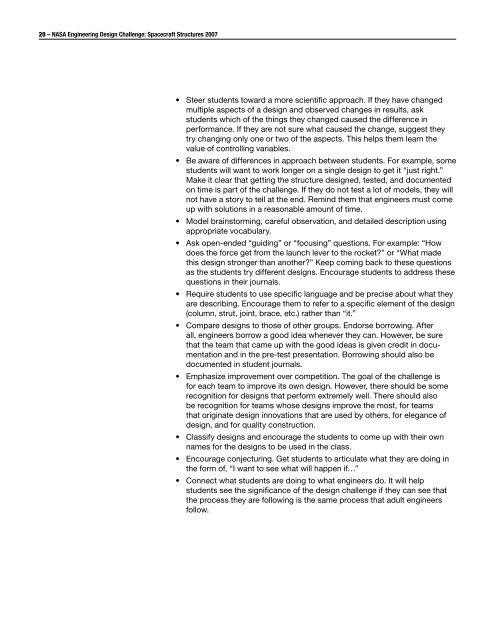Spacecraft Structures pdf - ER - NASA
Spacecraft Structures pdf - ER - NASA
Spacecraft Structures pdf - ER - NASA
- No tags were found...
Create successful ePaper yourself
Turn your PDF publications into a flip-book with our unique Google optimized e-Paper software.
20 – <strong>NASA</strong> Engineering Design Challenge: <strong>Spacecraft</strong> <strong>Structures</strong> 2007• Steer students toward a more scientific approach. If they have changedmultiple aspects of a design and observed changes in results, askstudents which of the things they changed caused the difference inperformance. If they are not sure what caused the change, suggest theytry changing only one or two of the aspects. This helps them learn thevalue of controlling variables.• Be aware of differences in approach between students. For example, somestudents will want to work longer on a single design to get it “just right.”Make it clear that getting the structure designed, tested, and documentedon time is part of the challenge. If they do not test a lot of models, they willnot have a story to tell at the end. Remind them that engineers must comeup with solutions in a reasonable amount of time.• Model brainstorming, careful observation, and detailed description usingappropriate vocabulary.• Ask open-ended “guiding” or “focusing” questions. For example: “Howdoes the force get from the launch lever to the rocket?” or “What madethis design stronger than another?” Keep coming back to these questionsas the students try different designs. Encourage students to address thesequestions in their journals.• Require students to use specific language and be precise about what theyare describing. Encourage them to refer to a specific element of the design(column, strut, joint, brace, etc.) rather than “it.”• Compare designs to those of other groups. Endorse borrowing. Afterall, engineers borrow a good idea whenever they can. However, be surethat the team that came up with the good ideas is given credit in documentationand in the pre-test presentation. Borrowing should also bedocumented in student journals.• Emphasize improvement over competition. The goal of the challenge isfor each team to improve its own design. However, there should be somerecognition for designs that perform extremely well. There should alsobe recognition for teams whose designs improve the most, for teamsthat originate design innovations that are used by others, for elegance ofdesign, and for quality construction.• Classify designs and encourage the students to come up with their ownnames for the designs to be used in the class.• Encourage conjecturing. Get students to articulate what they are doing inthe form of, “I want to see what will happen if…”• Connect what students are doing to what engineers do. It will helpstudents see the significance of the design challenge if they can see thatthe process they are following is the same process that adult engineersfollow.
















